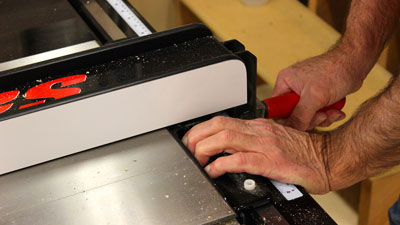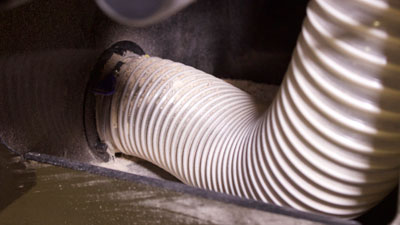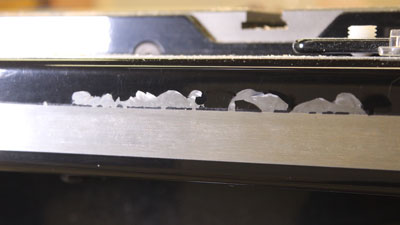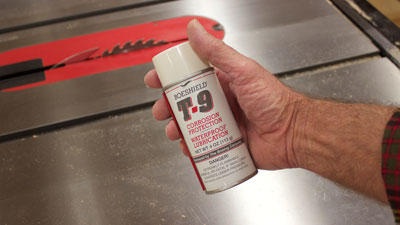
 by Steven D. Johnson
by Steven D. Johnson
Racine, Wisconsin
This month:
•
SawStop Long Term Look
•
Andrei The Excited
•
Killin' Time - Ennui Or Awe, It's Your Choice
•
Side-By-Side Product Showdowns – Next Month!
SawStop – A Long Term Look
Click on any picture to see a larger version.
After a mile of lumber and an acre of plywood, I'm getting used to the
SawStop PCS
, its features, its eccentricities and its nuances. It has become second nature to turn on the power switch in addition to the paddle switch to get the blade turning. I am no longer even cognizant of the few seconds of "boot up" self-diagnostic time before the green "good to go" light comes on, and the truth is I appreciate the extra level of security/safety allowed by being able to cut off the power at the control box… even though in an abundance of caution, I still unplug the saw before changing a blade.
Changing from a regular blade to a dado stack and back is only mildly complicated by the need to change the brake cartridge. It is a few additional seconds, forty-five at most. And with each change comes an opportunity to blow the dust away from inner workings on the machine… always a good thing to do. I am very accustomed to cranking the blade to its highest setting to make a table saw blade change, but with the SawStop there is a lot of room inside and I have made blade changes without even resetting the cutting height.

|
Figure 1 - Use one hand to keep the fence from
"jumping" while clamping down with the other
|
The jumpy fence is still jumpy, but I've learned to use both hands… one to hold the fence solidly in position and the other to clamp it down, thus minimizing the distracting side-to-side movement of the fence.
The miter gauge doesn't bother me anymore; it is really no better or worse than any other saw-supplied miter gauge. It doesn't bother me because I replaced it with an after-market gauge that is incrementally better.
As intended, I built the entire
Outfeed Table project
using the SawStop, along with its stock supplied blade, the stock miter gauge, and only a cross cut sled as an add-on. But as soon as the Outfeed Table project was completed I switched to a
Forrest Woodworker II Blade
(thin kerf with blade stiffener) and an after-market miter gauge… total additional cost, a little less than $400. But that should not be considered unusual or outrageous, as I would have done the same regardless the brand of table saw. It still baffles me that saw manufacturers even bother to supply a blade. Why doesn't SawStop, an obviously enterprising and creative company, set up a co-marketing agreement with a top line blade manufacturer? That company could supply blades with each new SawStop table saw… it would get people started off right and secure repeat business and long-lasting customer relationships for the blade manufacturer.

|
Figure 2 - Cause or effect? This bend is where the
wood chip clogs occurred
|
I've used the dado stack quite a bit, and on two occasions the dust collection hose inside the SawStop clogged. The first time I thought it might have been my fault. My
JDS Dust Collection System
is so powerful that on many tools I have to partly open an additional blast gate so that the suction is not too great for the machine I am using. I had inadvertently left another gate partly open. The second time, however, it plugged with even the full, undiluted power of the JDS dust collector. The cause is likely the rather tight bend in the hose (see photo) combined with hogging out a high volume of material with a wide dado stack. It probably will never happen to most users. My advice, take it slow.

|
Figure 3 - The paint is peeling off the square
front fence mounting tube
|
The square steel tube that attaches to the front of the saw provides the registration and mounting for the fence. On my saw, not yet a half-year old, the paint is coming off (see photo). At first I thought that maybe my belt buckle had inflicted the damage (why do I always assume it is something I did?), but my belt is too high (or my legs are too long), so this is just a flaw in the paint job. It's not the end of the world, but a minor annoyance on a machine in this price range.
Having had a Powermatic table saw, I was accustomed to silky smooth and quiet operation, and the noise from the SawStop was a little off-putting. As it turns out, that noise was largely attributable to the blade. After switching to the Forrest blade, the dB subsided significantly.

|
|
Figure 4 - T-9... still the best. Buy the large cans!
|
Any cast iron machine top requires a degree of rust vigilantism, but you will need to be extra cautious with the SawStop. The exact same application of
Boeshield T-9
on my jointer will keep rust spots at bay, but tiny spots will start to show on the SawStop within days. Based on a recent positive review in another publication I gave the CRC 3-36 product a try, but it did not perform any better than T9 and the stuff really stinks. I mean CRC 3-36 really smells bad… like raw sewage… no, like fermenting raw sewage… no, no, fermenting raw sewage inside a vinegar plant… downwind from a nuclear meltdown… there we go, that's about right. You might like it. I started buying T9 in larger cans and putting it on heavier.
I love measuring tapes. Even off-the-shelf tapes seem so lefty-friendly in a world of right-handed stuff. The SawStop seems unusually comfortable in use for this southpaw, like my favorite tape measure. In fact, while I usually adapt to any machine in time, I cannot remember being more immediately left-hand comfortable with any machine. I took to the machine like a duck to water. I've never heard anyone say that the SawStop is uncomfortable for right-handed people, so my feeling of left-handed comfort could be psychological or just an unfounded dumb opinion, but I'm entitled every once in a while.
I installed the
Overarm Dust Collection Attachment
and removed it twenty minutes later. I packed it back in its box and stowed it away. I will never use it. It would have required considerable "fiddling" to get it to work with my outfeed table, and as the old saying goes, "the view just wasn't worth the climb." With a powerful enough dust collector, the dust spewing from the blade above the table is minimal.
Speaking of dust collection, due to the effective lower blade shroud and dust hose-to-port system employed inside the SawStop, the dust collection is quite good. However, due also to this configuration, I am not sure the machine could be run without a dust collector. I know, I know, everyone should be using a good dust collector, but let's face it, some folks don't. And I think if you were to use the SawStop for even a few minutes without a dust collector, you would have quite a clogged up mess down below. Just sayin'…
The zero clearance inserts are ingeniously designed and work perfectly. These are a definite high spot in the overall saw design. The riving knife is easy to remove and easy to reinstall. There are enough adjustments on the machine to satisfy even the most devout tinkerer, and the instruction and assembly manuals are legendary. The mobile base is substantial and works very well. All in all, this is still, in my opinion, a saw that represents the current best price/value combination in the market. And the blade brake safety mechanism is a real bonus.
Online review formats usually include the question, "Would you recommend this product to a friend?" The answer is yes. An emphatic "yes." The fact is, I would even recommend it to an enemy (if I had an enemy). Everyone deserves a good table saw!
(Page 1 of 4)
1
2
3
4
Next Page
Return to
Wood News
front page

